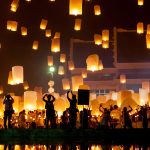Last week, we talked about Mid-Autumn Day’s origin as a harvest celebration based on the Chinese lunar calendar. One of you asked me to elaborate more on the concept of lunar calendar, especially given its significance and implications in many aspects of the Asian culture.
Many ancient civilization has their own lunar calendar. The lunar calendar we normally refer to in Asian culture is the Chinese lunar calendar. Its calculation is very intricate and complex. Contrary to its name, the Chinese lunar calendar isn’t just based on the moon. It’s actually a lunisolar calendar. A lunisolar calendar doesn’t just measure the phases of the moon, but also the position of the sun in the sky. Instead of following the solar calendar in having one leap day every four years, the Chinese lunar calendar introduces a leap month every three years instead.
The simplest way to understand all this is to basically count the moon cycles from one “spring” (Chinese New Year) to the next. Chinese month begins with new moon, and have a full moon on day 15. As a new moon comes roughly every 29½ days, Chinese lunar calendar month always have 29 or 30 days. That’s why the dates on the lunar calendar change every year, making it difficult to keep up with. This lunar calendar system isn’t limited to the Chinese culture. It is also widely used in Korean, Vietnamese, Japanese, and other Asian countries.
So, why do Asian cultures continue to use this complex lunar calendar? Especially since they have already adopted the Gregorian Calendar like the rest of the world?
- Its origin in agriculture has significant impact on people’s everyday life in modern times.
- For 3,000 years, the lunar calendar served the purpose of guiding agricultural affairs and farming activities by dividing the year into 24 solar terms. The solar terms are used to reflect the change of seasons, dividing the year into 4 seasons of exactly three months. They were extremely accurate in predicting the change of temperature and daylight, time and intensity of precipitation, maturity and harvest time of crops, and even insect activities. In 2016, Chinese 24 Solar Terms was added to UNESCO’s List of the Intangible Cultural Heritage of Humanity.
- Although agriculture is no longer a major part in the modern society, these terms continue to influence Asian people’s lifestyle habits. For example, every Asian kid has familiar with their mom’s nagging about wearing an extra layer – because “today is ‘Minor Cold (小寒)’ according to the lunar calendar.” Many Asian cultures emphasize specific food on these solar terms to maintain a healthy diet. For example, “Waking of the insects (惊蛰)” is still one the most expensive days to buy pears in China. People believe eating pears around this time of the year can prevent cough and other cold-related symptoms as spring starts.
- Major life events have to be approved by the lunar calendar.
- Many Asian people celebrate their lunar birthdays instead of the date in Gregorian Calendar. In general, a person is one or two years older in the lunar calendar due to the difference in the dates. It is also because many Asian cultures, like Chinese and Koreans, count the time spent in womb towards the baby’s age.
- Consulting the lunar calendar to pick an auspicious date and time for major life events is an important tradition in Asian cultures, including weddings, relocation, open of business, etc. It is fairly common for Asian American house buyers to refuse closing escrow on a specific date or time if deemed unfit according to the lunar calendar. The same goes for wedding planners, business owners, travel agents, and the list goes on. You may call it superstition, but many Asian Americans continue to follow these traditions for generations.
- Major festivals are based on the lunar calendar.
- Traditional holiday celebration was an essential part of harvests or prayer offerings. Therefore, most of them are calculated based on the lunar calendar: Lunar New Year, Mid-autumn Day, Lantern Festival, just to name a few. That’s why the exact date of these holidays vary every year.
- For example, Lunar New Year was closely tied to annual ancestry ceremonies at the beginning of a new year. In the old farming days, this is also the only time period when farmers could rest from their work in the fields. That’s the only reason week-long celebration was possible back then. Today, many of these festivals have became national holidays where everyone get to enjoy an entire week off to celebrate, travel and be together with families.







